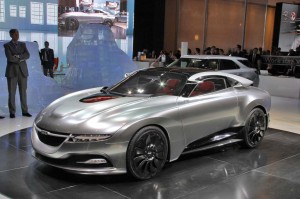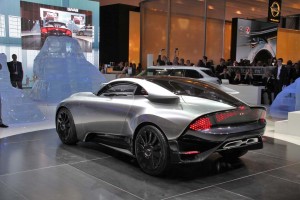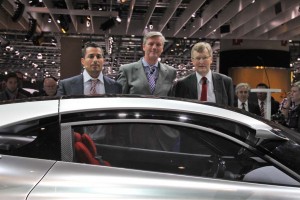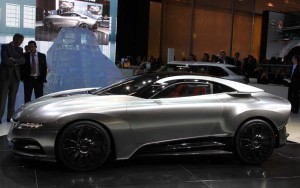It’s been just over a year since Saab rose from the dead, Lazarus-like, after an 11th hour deal saved the former General Motors division from being shut down. It’s been a serious challenge for the Swedish automaker to get that message out to potential buyers, but it will be difficult to ignore once they get a glimpse of the appropriately named Saab Phoenix Concept.
Making its debut at the 2011 Geneva Motor Show, the Phoenix flowed from the pen of Jason Castriota, the multi-talented designer responsible for a variety of exotic products, such as the Maserati Birdcage concept and the Ferrari 599 GTB. Castriota is now styling chief of Saab and searching for the formula that will help turn the upcoming 9-3 replacement into more than just a market afterthought.
The Phoenix goes off in a decidedly different direction from Saab’s last show car, the Aero-X — which strongly influenced both the new Saab 9-5 and 9-4X crossover.
In an interview at the Geneva show, the young designer suggested the styling language of the Phoenix show car might best be described as “aero-motional,” a reference to Saab’s aerospace roots. The front end of the prototype, he explained, has an almost nose cone-like shape, flowing into a fighter jet like body. With its highly aerodynamic Kamm back, the Phoenix show car has a surprisingly sleek 0.25 coefficient of drag, on a par with some of the best race cars.
No, you won’t see it reappear intact, in 2012, as the next 9-3, unlike some of the other, thinly disguised “concept” vehicles at the Geneva Motor Show. There will be significant changes to reflect the realities of manufacturing – and marketing. So, forget the Phoenix’s sideview video cameras.
Nonetheless, insists Castriota, the concept vehicle’s underlying design cues will be back when the 9-3, Saab’s bread-and-butter model, goes through a complete remake. And that’s understandable considering the challenges it faces. Not only must Saab prove it is still around, but it must also give potential customers a viable reason to consider its products instead of those from more firmly established brands, like the BMW 3-Series or Audi A4.
“You don’t want to have a wooden spoon in a knife fight,” is how Castriota puts it.
The new 9-3 has been in development for quite some time. In fact, the original plan, conceived prior to the sale of Saab, was to base it on one of GM’s global platforms, likely either the Epsilon or Delta “architectures,” reveals Jon-Ake Jonsson, the Swedish maker’s CEO.
But once Saab was sold to Dutch-based Spyker, the new owners realized it was best to start all over again. And what they realized they needed was not only a more modern platform but a more flexible one.
The Phoenix Concept, it turns out, is based on that new Phoenix architecture. Key design changes included moving the wheels out to the corner and widening the platform. But more significantly, it is now capable of serving as the mechanical foundation for a wide variety of products, longer, wider and taller – which means not just the next 9-3, but also the eventual replacement for the 9-5, the model that marked the revival of Saab, last year. It could also become the platform for the even newer 9-4X crossover’s ultimate replacement.
And, at one time, Saab engineers considered the possibility of using Phoenix for the small 9-2 model that is “a top priority” for new owner Victor Muller. But, at this point, adds Jonsson, that idea has been “ruled out.”
Instead, he and Muller believe they’ll need to find a partner to share in that project’s development. The good news, to the Dutch Muller, is that since the economic crisis began, “everything has changed. Now people are willing to share everything. That means access to technology is not just available, but affordable.”
Muller notes the maker has already landed a deal with BMW to provide engines for future Saab products. Other possible deals could follow, though it doesn’t appear anything is imminent.
If the 9-2 doesn’t materialize, says Muller, the company will still be on plan, and that means a goal of breaking even at just 80,000 vehicles annually, well short of Saab’s previous peak of 120,000.
To get there, the maker now has a broader line-up than at any time in its history. Indeed, along with the Phoenix Concept, Saab had a number of other introductions at the Geneva Motor Show, including the limited-edition 9-3 Independence Convertible. Based on the maker’s current 9-3, only 366 will be built marking the number of days in the year – plus one – since its unexpected revival.
Showgoers will also get a glimpse of the Griffin model, and the all-new Saab 9-5 SportCombi, Swedish-speak for a sporty wagon built off the new 9-5 platform.




